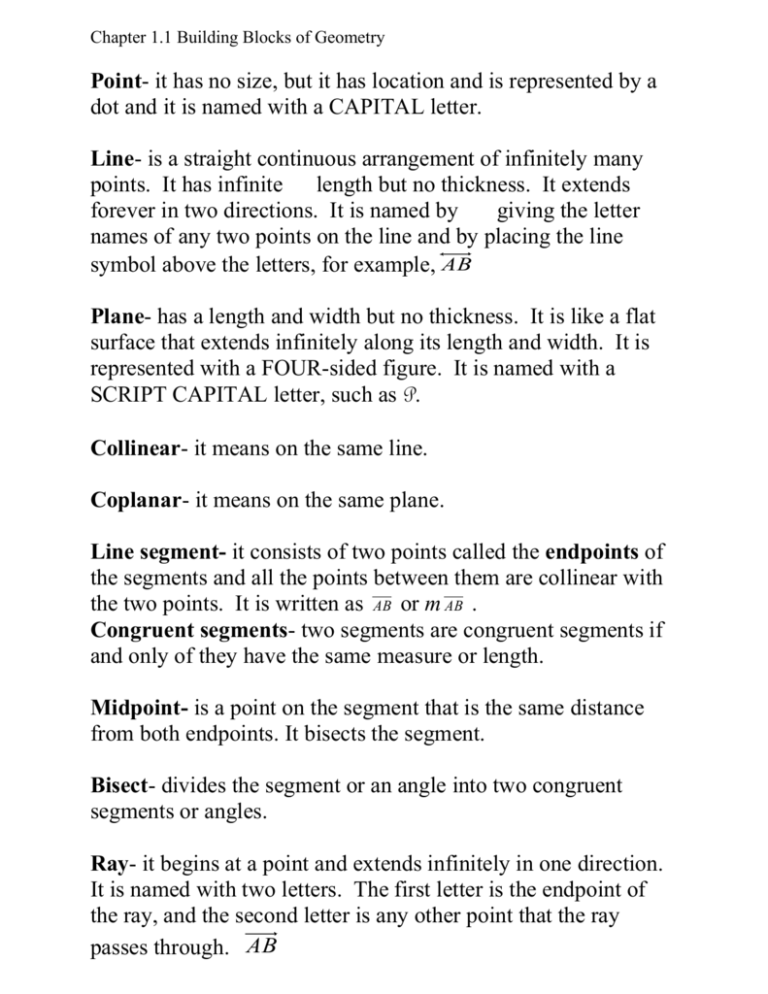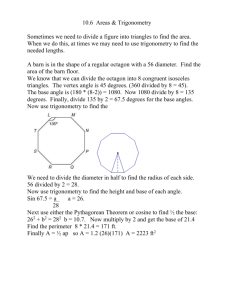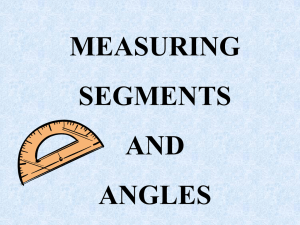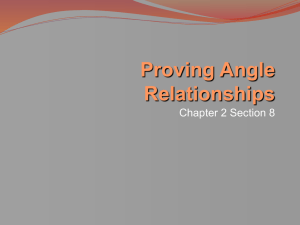Chapter 1
advertisement

Chapter 1.1 Building Blocks of Geometry Point- it has no size, but it has location and is represented by a dot and it is named with a CAPITAL letter. Line- is a straight continuous arrangement of infinitely many points. It has infinite length but no thickness. It extends forever in two directions. It is named by giving the letter names of any two points on the line and by placing the line symbol above the letters, for example, AB Plane- has a length and width but no thickness. It is like a flat surface that extends infinitely along its length and width. It is represented with a FOUR-sided figure. It is named with a SCRIPT CAPITAL letter, such as P. Collinear- it means on the same line. Coplanar- it means on the same plane. Line segment- it consists of two points called the endpoints of the segments and all the points between them are collinear with the two points. It is written as AB or m AB . Congruent segments- two segments are congruent segments if and only of they have the same measure or length. Midpoint- is a point on the segment that is the same distance from both endpoints. It bisects the segment. Bisect- divides the segment or an angle into two congruent segments or angles. Ray- it begins at a point and extends infinitely in one direction. It is named with two letters. The first letter is the endpoint of the ray, and the second letter is any other point that the ray passes through. AB Chapter 1.2 Poolroom Math Pg. 38 Angle- an angle is formed from two rays that share a common endpoint and are NOT collinear. Vertex- it is a point where two rays meet. Side- the two rays are the sides of an angle. Naming- when naming an angle, the vertex must be in the middle or an angle can be named by its vertex unless the vertex is shared by another angle. Measure- angles are measured in degrees. Degrees- an angle can have a measure of 0-360º. Angle Bisector- is a ray that contains the vertex and divides the angle into 2 congruent angles. Chapter 1.3 Pg. 47 What’s a Widget Parallel- lines in the same plane that never meet or intersect. Perpendicular- lines that intersect at a 90º angle. Skew- lines in different planes that never intersect. Counterexample- is an example to try to disproves a statement. Right angle- a right angle is an angle that measures 90º. Acute angle- an angle measures less than 90 º. Obtuse angle- an angle measures more than 90 º but less than 180 º. Pair of vertical angles- angles that are formed by two intersecting lines; they share a common vertex but not a common side. Linear Pair of angles- they share a vertex and a common side and their non-common side form a line. Pair of Complementary Angles- they add up to 90 º. Pair of Supplementary Angles- they add up to 180 º. *The difference between supplementary angles and a linear pair is, linear pair has to be supplementary and supplementary angles do not have to be a linear pair. Chapter 1.4 Polygons pg. 54 Polygon- is a closed figure in a plane, formed by connecting line segments endpoint to endpoint with each segment intersecting exactly two others. Side- the side of a polygon is a line segment. Vertex- this where the endpoints meet. Diagonal- a line segment that connects 2 non-consecutive vertices. Convex- no diagonals outside of the polygon. Concave- at least one diagonal is outside the polygon. *The shape is caved in* Congruent- if corresponding sides and angles are congruent, then polygons are congruent. Equilateral- all equal sides Equiangular- all equal angles Regular Polygon- polygons that are equiangular and equilateral. # sides Name 3 4 Triangle Quadrilateral 5 6 Pentagon Hexagon 7 8 Heptagon Octagon 9 10 Nonagon Decagon 11 12 Undecagon Dodecagon 13 N-gon Chapter 1.5 pg. 59 Triangles and Special Quadrilaterals Things you CAN assume in Geometry 1) lines are straight 2) when two lines intersect, they intersect at a point 3) everything in a picture is coplanar Things you can NOT assume in Geometry 1) parts are congruent *they must be labled 2) lines are parallel 3) lines are perpendicular Right Δ- has one right angle. Acute Δ- has three acute angles. Obtuse Δ- has one obtuse angle. Scalene Δ- a triangle with no congruent sides. Equilateral Δ- a triangle with three congruent sides. Isosceles Δ- it has at least two congruent sides. Vertex angle- made from two congruent sides. Base angle- has one side made from the base. Base- the base is the non-equal side and the side opposite the vertex angle. Trapezoid- it is a quadrilateral with exactly one pair of parallel sides. Kite- is a quadrilateral with consecutive congruent sides. Parallelogram- is a quadrilateral with 2 pairs of parallel sides. Rhombus- is an equilateral parallelogram. Rectangle- is a quadrilateral with 2 sets of parallel sides (across from each other) and four congruent angles. Squarea) Regular quadrilateral b) Equilateral rectangle c) Equiangular rhombus.






